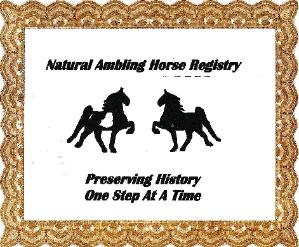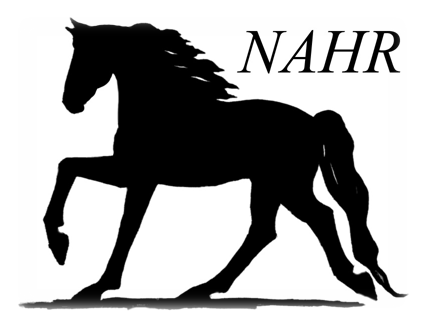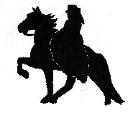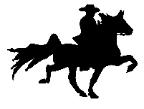


| History of the Ambling Horse |
| Natural Ambling Horse Registry · 619 Raiford Road · Erwin, North Carolina 28339 Copyright © 2010 NAHR. All rights reserved. |
An "amble" is a term used to describe a four- beat gait faster than a walk, but slower than a canter or gallop. The term can be used to describe a number of gaits including the rack, indian shuffle, running walk, tölt, paso fino, paso corto, paso largo, marcha picada, center march and even the slightly uneven fox trot. Though the speed, timing and footfall pattern differ for many of these gaits, they were once collectively referred to as an "amble" and horses who could execute them correctly and without the use of excessive artificial aids and extensive training were prized for the comfortable ride. Modern Ambling Breeds The following breeds may have natural ambling ability from birth: Albanian, American Curly, American Saddlebred, American Gaited Pony, Andean, Appaloosa, Asturian, Campolina, Candian, Cape Horse, Florida Cracker Horse, Icelandic Horse, Kentucky Mountain Saddle Horse, Mangalarga Marchador, Marwari, McCurdy Plantation Horse, Missouri Fox Trotter, Morgan, Mountain Pleasure Horse, Mule, Mytilene, National Show Horse (Arabian / American Saddlebred), North American Singlefooting Horse, Paso Fino, Peruvian Paso, Racking Horse, Rahvan, Rocky Mountain Horse, Sable Island Horse, Spanish Jennett, Spanish Narragansett, Spotted Saddle Horse, Standardbred, Tennessee Walking Horse, Tennuvian (Tennessee Walking Horse / Peruvian Paso), Tiger Horse, Trottingbred, United Mountain Pleasure Horse, Walkaloosa (Tennessee Walking Horse / Appaloosa), Wushen Mongolian. Ambling Horse History Modern day conceptions of the gaited horse breeds are based on short sighted historical records dating back to the early 1800’s. After much research and historical records searching, many brief references to horses that produced a “gait” were found. Interestingly, many of the references place gaited horses at several significant historical happenings. Historical references to horses that moved forward at a “gait” or an “amble” have been noted as far back as 6000 years BCE. From 6000 to 4000 BCE historical references indicate that horses were domesticated by the Indo-Iranian and Celtic tribes. Archeological evidence shows the use of wooden bits. This first reference to the Celts domesticating the horse is significant as the next historical reference found suggests that the Celts kept and rode small “gaited” horses. Historical references indicate that Celts, riding small gaited horses, migrated to Europe around the year 2000 BCE. It is suggested that these small gaited horses are the foundation blood stock for the later known Austurcons, Galacians and Garranos gaited horse breeds. 1000 BCE historical references indicate the existence of a newly developed gaited horse breed in central Asia. This new breed was called the Nisean. In 700 BCE, history indicates the arrival of Celts to the Iberian Peninsula renaming it Lusitania. It was here that the Celts bred a new Gaited horse well known even know as the Lusitano. In 600 BCE, Celts migrate to Ireland where a smaller version of the gaited horse was developed giving rise to the Irish Hobby horse. In 50 BCE, the upper class of Rome take note of the Ambling horse breeds of the Celts and of Asia, Importing horse of the Lusitano and Nisean breeds. In 45 BCE, historical references indicated that Julius Caesar invades Great Britain, introducing gaited horses of Gaulish heritage. In 71 AD, a historical reference states that the Austurcon ponies are crossed with several gaited Celtic breeds to produce the English hobbie horse. In 618 AD, the T’Ang dynasty in China breed a horse, in which “gait” is encouraged. This new breed was called the Soulon. The Vikings settle Iceland in 874 AD bringing with them Spanish bred horses using them to produce a gaited horse line. In 1172 AD, the Normans invade Ireland bringing with them larger horses that are introduced to the smaller gaited horses of the Celts. This cross adds size to the gaited Celtic horses. The Paso Fino breed comes into existence when Spain colonizes Puerto Rico in 1508 AD. In 1665, the Andalusian horse, having been bred partly from the gaited Irish Hobbie, was used to create the Narragansett Pacer. This is where popular modern gaited horse history begins. In the year 1674, at a Spanish mission in Florida, near the Apilachicola River, The Florida Cracker gaited horse was produced. In the year 1802 is where the names we commonly see in OUR gaited horse pedigrees begin to appear. In Canada, a colt by the name of Tom Hal is foaled. Tom was later recognized as one of the first foundation sires of the American Saddlebred horse breed, being issued the registry number ASHA # 3237. Tom Hal sires a colt named Bald Stockings. Bald Stockings goes on to sire the first recognized American Gaited Horse. In 1808 The Royal Portuguese family of Dom Joao the sixth moves to Brazil bringing with them a handful of the Alter-Reals gaited horses. The Alter-Reals were used in the production of the famous Paso gaited Mangalarga Marchador. In 1862 in Petersburg, Tennessee, a blue roan colt was foaled and registered as Tom Hal F-20 in the Tennessee Walking Horse Registry. In 1891 The American Saddlebred Association is founded. 1903 marks the year in which most great names in the gaited horse breed become significant. IN this year, James R. Brantly purchased a Standardbred colt named Black Allen, Mr. Brantly renamed the black colt Allan and used him to stud his mares to produce a new breed of gaited horse. Mr. Brantly bred Allan to his best mare Gertrude, an American Saddlebred, Morgan, Canadian Pacer cross and the resulting foal is the now famous and well known Roan Allan. Another famous name produced from this line was Stonewall Allan TWHBEA # 360195 On May 8th 1941, Sandy’s Sun Sally, foundation dam to all spotted Tennessee walkers is foaled. May 1941 also marks the foaling of Allen’s Golden Zephyer, TWHBEA # 431975 also known as Trigger Jr. History suggests that many historically significant people and events were somehow connected to the gaited horse. In many key points in history, gaited horses are mentioned as being present. Little known facts marked in history are that most kings and knights rode an ambling horse or Palfrey to battles before switching to their war horses. Queen Marie Antoinette rode an ambling Palfrey. George Washington, Andrew Jackson, Paul Revere, and General Robert E. Lee all rode ambling or gaited horses. |



